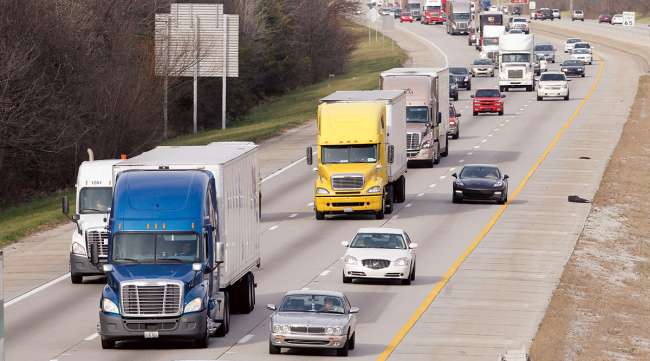Senior Reporter
ATA Truck Tonnage Index Declines 8.7% in October

[Stay on top of transportation news: Get TTNews in your inbox.]
Truck tonnage in October declined a seasonally adjusted 8.7% when compared with year-ago levels, marking the seventh consecutive month of year-over-year declines, American Trucking Associations said Nov. 24.
When measured month-to-month, the ATA For-Hire Truck Tonnage Index decreased 6.3% after increasing 5.7% in September. In October, the index equaled 106.8 compared with 114 in September. (The index equaled 100 in 2015.)
Year-to-date, tonnage is down 3.9% compared with 2019.

Costello
“While there are indications that the economy is losing momentum, I believe October’s tonnage softness was more of a seasonal issue during a pandemic than anything else,” ATA Chief Economist Bob Costello said. “Typical seasonality is off this year, and it was a reason why October was down so much.”
He added, “Not seasonally adjusted tonnage was down a fraction as much as normal over the last five years during September, leading to a big seasonally adjusted gain. However, that means October’s not seasonally adjusted tonnage grew less than half as much as it typically does, leading to a big drop in the seasonally adjusted figure. There are plenty of carriers still saying that tonnage, retail tonnage in particular, is good.”
However, Costello noted that the U.S. economy appears to be slowing after the record 33% jump in gross domestic product in the third quarter.
One bright spot in the economy, which is directly impacting trucking, continues to be home construction. On Nov. 18, the Census Bureau and the Department of Housing and Urban Development jointly announced that housing starts in October increased to 1,530,000. That figure is 14.2% higher than the October 2019 rate of 1,340,000 housing starts. Single-family homes dominate the construction industry, making up 91% of housing construction.

Home | Video | Heroes' Photo Gallery
Saluting the men and women of the trucking industry who kept America's essential goods flowing during the coronavirus pandemic.
Heroes: Peter Lacoste | Susan Dawson | James Rogers | Reggie Barrows | Kevin Cooper | Cesar Quintana Moreno
Costello and other economists said the surge in new construction is being driven by the COVID-19 pandemic and the desire of many people to live in less densely populated areas, and is beneficial for fleets that move lumber, plumbing, heating and air conditioning units, and electrical items.
“We are seeing an accelerated movement away from densely populated urban areas to the suburbs of those areas, or further out, or the far-out suburbs,” added Wells Fargo Senior Economist Mark Vitner, noting that the pandemic is compelling a period of historic growth for mid-sized cities. Going forward, he forecasts housing growth will be focused in these areas, especially in Southern and Southwestern states.
“Mid-tier cities are pretty big, they can have 2.5 to 3.5 million people,” Vitner said. “They’re pretty populated, and movement is historic. It will be one of the historic migrations in the history of the U.S.”

Dhawan
Economist Rajeev Dhawan, the director of the Economic Forecasting Center at Georgia State University, believes the pandemic has permanently changed how people look at their homes.
“There are two things happening,” he said. “Interest rates are very low, and now people can afford a bigger home. Plus, people realize that their houses are not just a place to sleep; you’re there 24/7, and what people want has changed.”
The weekly DAT Freight & Analytics summary of the trucking economy shows all trucking industry sectors are doing well, especially when measured against 2019 numbers.
Load-to-truck ratios moved lower last week, but localized capacity constraint continues to keep pressure on pricing. Read more in the latest DAT Trendlines report: https://t.co/3yGoF2acpV
— DAT Freight & Analytics (@LoadBoards) November 17, 2020
Weekly spot load posts were up 2.1% the week of Nov. 16-22, compared with Nov. 9-15. However, when measured year-over-year, posts were up 122.1%. Van load-to-truck numbers were up 6.9% for the third week of November compared with the second week, and year-over-year, they were up 156.3%. The flatbed numbers were similar, up 5.2% in the third week of November compared with the second week and up 243.4% compared with the same period in 2019. Refrigerated cargo showed a 1% weekly decline but is up 155.3% year-over-year.
The Cass Freight Index of shipping volumes also shows the trucking economy is continuing to show strong growth.
“One of the drivers of the recent resurgence in freight activity has been healthy consumer spending, as U.S. retail sales had another very good month, increasing 5.2% year-over-year in October. This was driven by a mixture of the continued reopening of the economy and businesses, schools starting back up, and optimism around health care advances, including a vaccine,” said David Ross, author of the Cass report and managing director of global transportation and logistics equity research at Stifel.
ATA’s tonnage index is dominated by contract freight, as opposed to spot market freight. Costello noted that more than 80% of the freight carried in the U.S. is contract freight.
Want more news? Listen to today's daily briefing:
Subscribe: Apple Podcasts | Spotify | Amazon Alexa | Google Assistant | More




